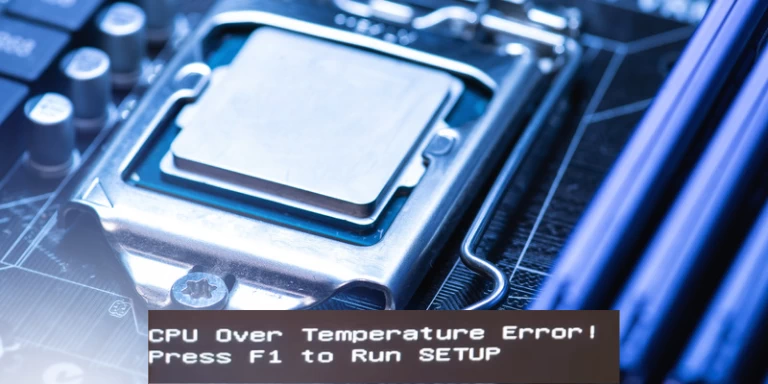CPU over temperature error is one of those errors that most computers encounter at least a few times in their life cycle. This error simply means that your PC’s cooler has failed to efficiently eliminate the heat generated by the CPU. As a result, your CPU is overheating, putting it at the risk of damage.
Most people tend to deem this error as ‘not dangerous’ and proceed to ignore it. But, we recommend that you take this error seriously, even if you’re receiving it for the first time.
Although the errors can be annoying, they are not inherently bad because they serve to warn you that the CPU is at a risk of damage due to overheating. This is why it is important to diagnose the cause and determine how to will fix it. Fortunately, this is what we’ll be discussing here.

In this guide we’ll focus on:
- What Causes The CPU Over Temperature Error?
- Common Causes Of The CPU Over Temperature Error
- When Is It Considered Dangerous?
- How To Fix A CPU Over Temperature Error
First, let’s look at what causes this error.
What Causes The CPU Over Temperature Error?
What if it is deemed potentially non-serious?
The cause of this error is quite obvious; your cooling system is unable to effectively get rid of the heat your CPU is producing, leading to overheating and unexpected shutdowns. This could occur when your cooling system is faulty, for example the heat sink is not properly connected. It can also occur when the CPU fan is not spinning as intended. Sometimes this error appears after heavy tasking for long periods, we’ll discuss this in detail in the next section.
When the CPU overheats, the system protection implements prevention mechanisms to avoid potentially disastrous problems. Your computer may be shutting down, and on startup, the PC’s POST report a “CPU over temperature error.” In some cases, if the CPU becomes overheated, your PC will implement a protection mechanism by attempting to reduce performance.
Common Causes Of The CPU Over Temperature Error
If you’re just getting this error for the first time, don’t be worried, it might not be as big of a deal as you think it is. In some cases, this error does not necessarily spell danger for the CPU. As a result, you don’t need to panic.
Let’s say you have been carrying out heavy tasks such as video editing or gaming on your PC continuously over a long period. At some point, the cooling system is bound to come up short. Also, your fan may not be spinning properly because it is being hindered for example by dust buildup or entangled cables. In this case you can simply remove these obstacles and resume your routine.
RELATED: Causes of High CPU Temperatures And Fixing Measures
When Is It Considered Dangerous?
When a CPU over temperature error occurs frequently under normal conditions. By normal conditions we mean, when you’re performing light tasks on your PC for example:
- Watching videos on YouTube
- Creating and editing text documents
- Reading PDFs, and so on.
Here, you should be concerned and start looking for the cause of the problem and how you can fix it. We have gathered a variety of methods you can diagnose and fix this issue. You can do most of these solutions yourself, and you don’t need to get an expert.
To practice caution, you should always diagnose the cause of the error each time it is generated.
How To Fix A CPU Over Temperature Error
Check Thermal Paste, Replace If Necessary
One of the key components of a CPU cooler that often gets overlooked is the thermal paste. Thermal paste applied on your CPU works to enable the efficient transfer of heat from the CPU to the base of the heatsink. The heat produced by the CPU causes this semi-solid substance to dry, and this occurs after 2-3 years.
To check the thermal paste, you have to unscrew the CPU fan and heat sink. If you find it dried, you have to replace it. Thermal paste is primarily made from three compounds:
- Metal
- Ceramic
- Silicon
You should use high-quality thermal paste from well-known brands.
RELATED: Does Thermal Paste Expire?
Check CPU Utilization And Perform A Clean Boot
It is always a good idea to start simple. Before you proceed to the complicated stuff, how your CPU is being utilized on the task manager. To check CPU utilization:
- Start by launching ‘Ctrl+Alt+Del’ and select task manager.
- Click on the Performance tab and check the percentage of CPU that is being utilized.
If it is between 90 – 100%, the CPU over temperature error will likely occur. If you’re not running any heavy tasks on your device, this could be caused by unknown 3rd party background application or malware. Then you can proceed to perform a clean boot.
A clean boot starts your PC with a minimal set of drivers and programs, to help you determine if a background application is responsible for inflating CPU utilization. To perform a clean boot:
- Sign in as administrator.
- Press the windows button and type msconfig on the search box, click on System config.
- Click on the Services tab and select Hide all Microsoft services> Disable all.
- Open task manager under the startup tab and for each item, select it then click on Disable.
- Close the task manager and then reboot your PC.
Check If The CPU Fan Is Connected To The CPU_FAN Header
Most manufacturers currently release motherboards with multiple fan headers for the CPU fan, optional fans, and chassis fans. It is mandatory to have the CPU cooler (whether liquid or air) connected to the CPU_FAN header.
Open the case and locate the CPU_FAN header on the motherboard. Ensure that the CPU_FAN is first connected properly to this header. If this is the case, you should attempt connecting the CPU cooler to alternative headers (CPU_FAN 1, CPU_FAN 2).
RELATED: CPU FAN vs CPU OPT Fan Headers
Check If The CPU Fan Is Mechanically Damaged.
You can also look around to see if the fan and heatsink are intact, sitting on top of the CPU. Ensure all the screws have been tied.
Perhaps the CPU fan has become stuck or the fan blade has become damaged. Even if the fan is spinning normally, it will not be able to cool your device. In case you find everything is okay and there’s still an error, you might want to consider adding more fans to help cool your system.
Clean Heatsink And CPU Fan
Dust and oil particles can insulate the heatsink, preventing it from optimally dissipating the heat produced by the CPU. Alternatively, dust can clog the CPU fan, preventing it from spinning properly. If you open the case and find dust particles on the heatsink and the CPU fan, it’s time to clean them.
Using compressed air to clean a CPU fan is the most secure method. You must remove the fan and heatsink before doing this.
To clean off the dust that has accumulated on the CPU fan, gently wipe off the dust from each blade, use a dry piece of cotton wool or one dipped in isopropyl alcohol (or another appropriate organic solvent). If your PC is frequently used in the presence of cigarette smoke, a damp piece of cotton wool is required. After cleaning, make certain that everything is properly reconnected.
Ensure You Have The Right Cooler For Your CPU
When building your PC, it is crucial to get a cooler with the capacity to efficiently cool your CPU. It is always advisable to get a cooler from the same brand as the CPU, for example AMD’s Wraith coolers for AMD Ryzen 7 series. Some of you might opt for coolers from third party vendors like Thermalright, Noctua, Corsair, etc.
To ensure that you have the right cooler, go to the products specification pages of both the CPU and the cooler. Then, compare the TDP socket information of the CPU and the cooler. The TDP value of the cooler must be higher than the TDP value of the processor.
Restore The CPU Clock Speed To Default
If you have overclocked your CPU before, you obviously know that it comes with additional cooling demands such as liquid cooling system. These demands could be too high for your current cooling system to meet causing it to generate the CPU over temperature error.
RELATED: Is Liquid Cooling Worth It?
In case you are unable to improve your cooling system, this can be fixed by restoring the clock speed to the default value. This way, the CPU does not overwork itself.
To do this:
- Boot your computer and press the F1, F10, or Delete key upon startup to get into BIOS.
- Restores the CPU’s previous setting values, returning them to their default values.
- Use the F10 key to save these changes and exit the BIOS.
The CPU’s default cooler should comfortably cool your system at the default performance values.
Conclusion
The CPU over temperature error is a very common error that occurs in most computers at some point. There are instances when it can be ignored without risking the damage of your motherboard components. However, when it occurs frequently under normal conditions, it should be taken seriously.
Fortunately, there are a number of software and hardware fixes you can attempt to fix this issue. If you have basic computer knowledge, you won’t need a technical expert to do this for you. So, when your computer generates the CPU over temperature error, you now know what to do.





